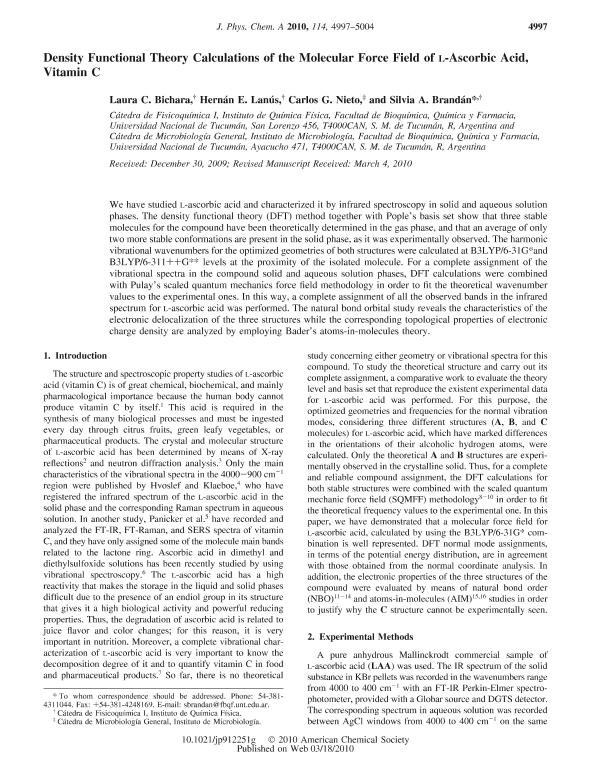Mostrar el registro sencillo del ítem
dc.contributor.author
Bichara, Laura Cecilia

dc.contributor.author
Lanús, Hernán Enrique

dc.contributor.author
Nieto Peñalver, Carlos Gabriel

dc.contributor.author
Brandan, Silvia Antonia

dc.date.available
2018-04-10T15:22:18Z
dc.date.issued
2010-04
dc.identifier.citation
Bichara, Laura Cecilia; Lanús, Hernán Enrique; Nieto Peñalver, Carlos Gabriel; Brandan, Silvia Antonia; Density Functional Theory Calculations of the Molecular Force Field of l -Ascorbic Acid, Vitamin C; American Chemical Society; Journal of Physical Chemistry A; 114; 14; 4-2010; 4997-5004
dc.identifier.issn
1089-5639
dc.identifier.uri
http://hdl.handle.net/11336/41494
dc.description.abstract
We have studied l-ascorbic acid and characterized it by infrared spectroscopy in solid and aqueous solution phases. The density functional theory (DFT) method together with Pople’s basis set show that three stable molecules for the compound have been theoretically determined in the gas phase, and that an average of only two more stable conformations are present in the solid phase, as it was experimentally observed. The harmonic vibrational wavenumbers for the optimized geometries of both structures were calculated at B3LYP/6-31G*and B3LYP/6-311++G** levels at the proximity of the isolated molecule. For a complete assignment of the vibrational spectra in the compound solid and aqueous solution phases, DFT calculations were combined with Pulay’s scaled quantum mechanics force field methodology in order to fit the theoretical wavenumber values to the experimental ones. In this way, a complete assignment of all the observed bands in the infrared spectrum for l-ascorbic acid was performed. The natural bond orbital study reveals the characteristics of the electronic delocalization of the three structures while the corresponding topological properties of electronic charge density are analyzed by employing Bader’s atoms-in-molecules theory.
dc.format
application/pdf
dc.language.iso
eng
dc.publisher
American Chemical Society

dc.rights
info:eu-repo/semantics/openAccess
dc.rights.uri
https://creativecommons.org/licenses/by-nc-sa/2.5/ar/
dc.subject
Ascorbic
dc.subject
Molecular-Force-Field
dc.subject.classification
Otras Ciencias Químicas

dc.subject.classification
Ciencias Químicas

dc.subject.classification
CIENCIAS NATURALES Y EXACTAS

dc.title
Density Functional Theory Calculations of the Molecular Force Field of l -Ascorbic Acid, Vitamin C
dc.type
info:eu-repo/semantics/article
dc.type
info:ar-repo/semantics/artículo
dc.type
info:eu-repo/semantics/publishedVersion
dc.date.updated
2018-04-03T21:09:39Z
dc.journal.volume
114
dc.journal.number
14
dc.journal.pagination
4997-5004
dc.journal.pais
Estados Unidos

dc.journal.ciudad
Washington, DC
dc.description.fil
Fil: Bichara, Laura Cecilia. Universidad Nacional de Tucumán. Facultad de Bioquímica, Química y Farmacia. Instituto de Química Física; Argentina
dc.description.fil
Fil: Lanús, Hernán Enrique. Universidad Nacional de Tucumán. Facultad de Bioquímica, Química y Farmacia. Instituto de Química Física; Argentina
dc.description.fil
Fil: Nieto Peñalver, Carlos Gabriel. Consejo Nacional de Investigaciones Científicas y Técnicas. Centro Científico Tecnológico Conicet - Tucumán. Planta Piloto de Procesos Industriales Microbiológicos; Argentina. Universidad Nacional de Tucumán. Facultad de Bioquímica, Química y Farmacia. Instituto de Microbiología; Argentina
dc.description.fil
Fil: Brandan, Silvia Antonia. Universidad Nacional de Tucumán. Facultad de Bioquímica, Química y Farmacia. Instituto de Química Física; Argentina
dc.journal.title
Journal of Physical Chemistry A

dc.relation.alternativeid
info:eu-repo/semantics/altIdentifier/doi/http://dx.doi.org/10.1021/jp912251g
dc.relation.alternativeid
info:eu-repo/semantics/altIdentifier/url/https://pubs.acs.org/doi/abs/10.1021/jp912251g
Archivos asociados
